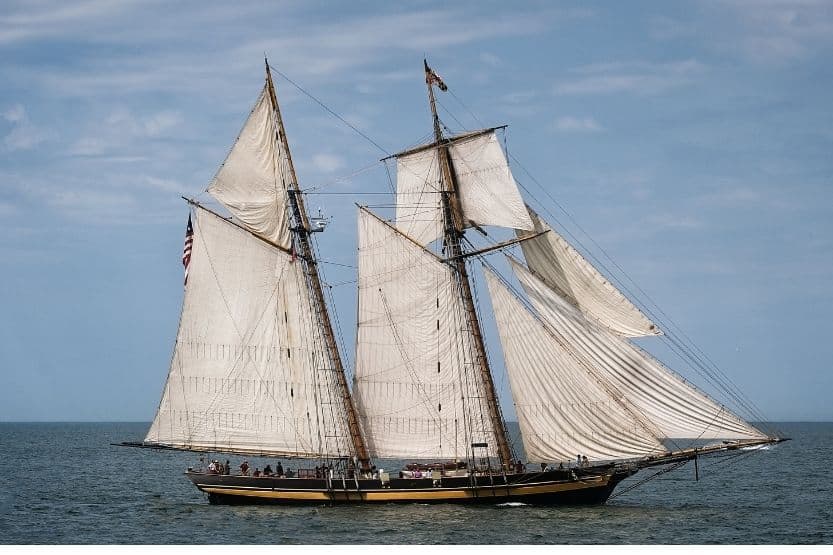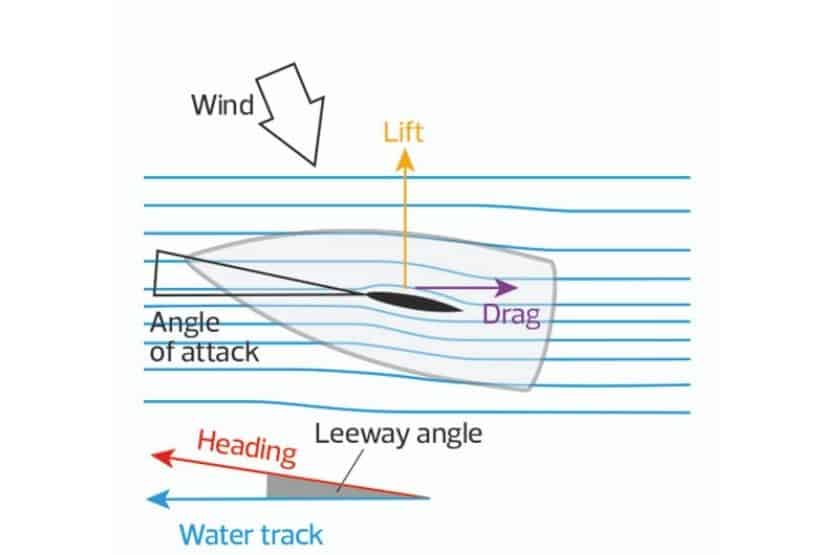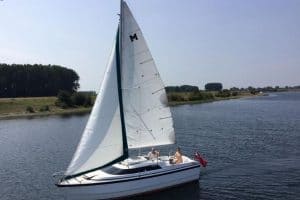It’s important to know common sailing terms so that you can communicate effectively with other boaters, especially during an emergency. Knowing many sailing terms will also make you a better sailor. What are the sailing terms you must know?
Five of the most basic sailing terms that you should know are as follows:
- Aft – the back of a sailboat.
- Bow – the front of a sailboat.
- Port – the left-hand side of a sailboat.
- Starboard – the right-hand side of a sailboat.
- Leeward – the direction where the wind is blowing towards.
There are many other sailing terms. We’ll list 59 sailing terms below, including basic nautical sailing terms and funny sailing terms.
Also, we hope you find the links here useful. We may get a commission if you purchase something through a link on this page, so thank you!

Read on to learn more about these commonly used nautical terms, including several funny sailing terms that boaters use.
Sailing Terms
Click here to see this TOPFORT 187/230pcs Fishing Accessories Kit on Amazon.
Below are 59 sailing terms that you should know to become a better sailor, in alphabetical order:
1. Above Board
This term refers to anything that is on or above the open deck. If you hear someone say that something is above board, it means something is in plain view.
2. Aft
Also called the stern, the aft refers to the back of a sailboat. If you hear a boater say that he has a spare rope located aft, this means that the spare rope is kept at the back of his sailboat.
3. Ahead
The term ahead refers to the forward of the bow.
4. Ahoy
Ahoy is a term that functions to draw the attention of others. You can utter this loudly to hail a boat, as in “Boat ahoy!”
5. Boom
A boom may refer to a floating barrier that helps control navigation into and out of harbors and rivers. It may refer to a spar fastened to the foot of a fore-and-aft sail.
It may also refer to a spar that extends the jib’s foot, gaffsail, or trysail, or a spar that extends square-rigged masts to carry studding sails.
6. Bow
The bow refers to the opposite side of the aft, which is the front of the sailboat. The aft and the bow are two important areas of the boat. Hence, they are terms often heard when sailing.
7. Brass Monkeys or Brass Monkey Weather
These sailing boat terms refer to freezing weather as if it would freeze cannonballs off a brass monkey. Brass monkey is widely believed to refer to a brass tray used in ships to store cannonballs during the Napoleonic Wars. To those who don’t know this, they find these to be funny sailing terms.
8. Cat Head
A cat head refers to a beam that extends out from the hull that supports and secures a raised anchor.
9. Cut of His Jib
For sailors, the term Cut means the shape. When you hear them say, “The cut of a sail,” this means the shape of the sail. When you hear them say, “The cut of his jib,” they are talking about the shape of the staysail at the front of a sailboat or ship.
10. Fathom
A fathom refers to a unit of length equivalent to 6 feet or 1.8 meters. On the estimate, this is approximately measured as the distance between a human’s outstretched hands.
11. Fish
This sailing term is a verb that means to repair a spar or a mast using a fillet of wood. It may also mean securing an anchor on the side of the vessel.
12. Forestays
Forestays refer to the long cables or lines connecting from the vessel’s front to the mastheads. Their role is to support the mast.
13. Gaff
A gaff pertains to a spar that securely holds the upper edge of a gaff sailor a fore-and-aft.
14. Gunwale
The gunwale refers to the upper edge of the hull.
15. Handsomely
When a boater asks you to haul on a line handsomely, it means to pull a line in a slow and even motion carefully. As one of those funny sailing terms, handsomely doesn’t have anything to do with boaters’ appearance.
16. In Irons
Another sailing term for wind is “In Irons.” This sailing phrase is heard when the boat’s bow is headed in the wind’s direction, disabling the boat to maneuver.
17. Jacklines or Jack Stays
Jack stays, or jack lines, refer to lines often made of steel wire wrapped in a plastic jacket. These lines connect from the bow to the stern on both the starboard and the port. The lines are clipped on the boaters’ safety harness to secure them while walking on the deck.
18. Jibing
Jibing is one of those sailing terms for wind that you’ll encounter. This refers to a basic sailing maneuver wherein the boater turns the stern through the wind, changing the wind from one side of the boat to the other.
When you perform a jibe or a tack, the boat’s boom will shift from one side to the other.
19. Know the Ropes
If you’re a sailor who knows the ropes, then you’re familiar with the ropes and cords required to run a ship or a boat.
20. Lee Side
The lee side refers to the side of a ship opposite the windward or the weather side.

21. Leeward
Also commonly called lee, this refers to the direction where the wind is blowing towards. This is one of the commonly used sailing terms for wind, specifically, the direction of the wind.
22. Lines
This term is often heard on board a boat. This is oftentimes, if not all the time, used to pertain to ropes.
23. Luff
The luff may refer to the sail’s forward edge. It may also mean to head a sailing vessel more towards the wind’s direction.
24. Lying Ahull
When you say lying ahull, it means waiting out a storm by letting the boat drift or dousing all sails.
25. Mainsail
The mainsail is a large triangular sail located aft of the boat’s mast. As the name implies, it is the largest, not to mention the most important, sail of a boat. It is attached to a thick pole commonly called boom.
26. Man Overboard!
This phrase means that a seaman has gone overboard.
27. Monkey Fist
A monkey fist pertains to a ball woven out of line. It is used to provide heft and heave the line to another location.
28. Moor
This nautical term means to fasten a boat to a mooring post or buoy. The term also means to dock a ship.
29. Navigation Rules
The navigation rules are road rules for boaters. They are guidelines that include collision prevention and detection of the causes of the collision.
30. No Room to Swing a Cat
When you hear sailors say that there’s no room to swing a cat or a whip, it means that an area is too crowded. For instance, if an assembly on deck and the area becomes too crowded, the bosun might not have room to swing a cat.
31. Oilskin
The term oilskin pertains to the foul-weather gear worn by sailors.
32. Outhaul
An outhaul refers to a line that controls the shape of a sail.
33. Overhead
When you hear the term overhead, this refers to the ceiling, which also is the bottom of the deck above you.
34. Ox-Eye
The term ox-eye refers to a cloud or any other weather phenomenon that indicates an upcoming storm’s likelihood.
35. Pontoon
A pontoon is a flat-bottomed vessel used as a float or a barge, or a ferry moored alongside a ship or a jetty to facilitate boarding.
36. Pooped
The term pooped is one of the more funny sailing terms because some take it quite literally.
However, this sailing term means exhaustion. It also means swamped by a high, following sea. So, when you hear someone say he’s pooped, it’s not what you think it is.
37. Port
There’s a term for the left-hand side of your sailboat when you’re facing the bow. It’s called the port. A red light is installed on it so that other boaters can identify which side your boat is facing when you sail at night.
38. Prow
A prow is another term for the bow. While the bow is the commonly used term by boaters, you’ll also hear this poetical alternative word from time to time.
39. Quayside
The platform or the dock where a vessel is fastened to is called the quayside.
40. Radar
Radar is an acronym that stands for Radio Detection And Ranging. It is an electronic system that transmits radio signals and receives their reflected images from the target, identifying its distance.
41. Rail Meat
Rail meat is a sailing term that refers to members of the sailboat crew that use their body weight to control the angle of the boat’s heel.
42. Reach
This term pertains to sail from approximately 60 degrees to roughly 160 degrees off the wind. There are three different types of reaching: Close Reaching, Beam Reaching, and Broad Reaching.
Close reaching refers to the point of sail from roughly 60 to 80 degrees. Beam reaching refers to the point of sail from more or less 90 degrees. At the same time, the board reaching refers to sail from about 120 to 160 degrees.
43. Ready About
The sailing phrase Ready About indicates a call for imminent tacking.
44. Rudder
A rudder refers to a flat piece of metal, fiberglass, or wood located beneath the boat that steers the ship. For larger sailboats, the rudder is controlled by a wheel. At the same time, smaller boats have a steering mechanism located aft.

45. Scud
Sailors or boaters use the term scud to describe the lowest clouds, often observed during squally weather.
46. Sheet
A sheet pertains to a rope that controls the sail’s setting in the wind’s direction.
47. Sick Bay
The sickbay refers to the boat’s compartment or area where medicines and other stuff for medical purposes are stored.
48. Starboard
The opposite side of the port is called the starboard. Evidently, it is the right-hand side of your sailboat when facing the bow. Boaters find the terms left and right quite confusing, especially during complex situations. Hence, their use of the terms port and starboard.
49. Staysail
A staysail pertains to a sail consisting of a luff fastened to a forestay.
50. Tacking
Tacking is the opposite of jibing and is one of the most important sailing terms. This is a basic type of sailing maneuver that pertains to the boat’s turn through the wind, changing the wind from one side of the boat to the other.
Similar to jibing, the boat’s boom shifts from one side to the other when tacking.
51. Topsail
This sailing term refers to the boat’s second sail up a mast. It may be fore-and-aft sails or square sails.
52. Touch and Go
When a boater says “touch and go,” it means the bottom of the vessel is touching the bottom but is not grounding.
53. Transom
The transom is what can be considered a flat surface across the vessel’s stern.
54. Turtling
This term is used to describe a condition when a sailboat capsizes. In which case, the mast is pointed straight down, whereas the hull touches the surface, resembling a turtle shell’s appearance.
55. Under the Weather
When a boater is under the weather, he is positioned on the vessel’s weather side. The boater serves as a watch and is often exposed to wind and spray.
56. Vanishing Angle
The vanishing angle refers to the heel’s maximum degree after a vessel cannot return to an upright position.
57. White Horses
White horses pertain to waves amid strong winds. They are strong enough to produce foam or spray on wave tops.
58. Windage
This term refers to the boat’s resistance to the wind.
59. Windward
The windward refers to the direction where the wind is currently blowing. In other words, it is the opposite of leeward.
Click here to see this Stohlquist Fit Adult PFD Life Vest on Amazon.
Conclusion – Sailing Terms
It is important to be familiar with the commonly used terms used by boaters. Five basic sailing terms that you should know are as follows:
- Aft – the back of a sailboat.
- Bow – the front of a sailboat.
- Port – the left-hand side of a sailboat.
- Starboard – the right-hand side of a sailboat.
- Leeward – the direction where the wind is blowing towards.
Familiarization with sailing terms comes truly handy to help you effectively and efficiently communicate with other boaters. This is especially true if you’re a beginner when it comes to sailing or just planning to purchase your very own boat.
Related reading:








